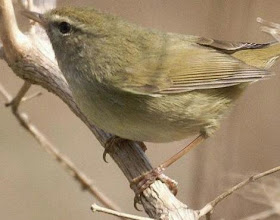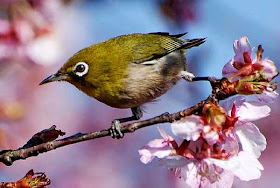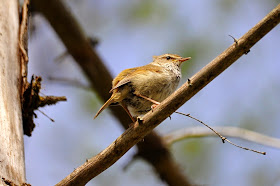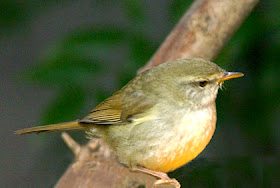Sunday, November 30, 2014
Uguisu
Uguisu Classification and Evolution
The Uguisu is a small species of bird that is natively found throughout Japan, China and Taiwan, along with a number of other regions of the far east. The Uguisu is also commonly known as the Japanese Bush-Warbler, as it is named for it's beautifully distinctive song. The Uguisu is most closely related to other small songbirds including Bushtits and Nightingales which they are similar in appearance too, although the Uguisu is generally very slightly larger. Although they do not sing at night, the beauty of the Uguisu's song is said to have led to them also being known as the Japanese Nightingale. The Uguisu was first described as a documented species by Heinrich von Kittlitz in 1830.
Uguisu Anatomy and Appearance
The Uguisu is a small-sized bird that is known for it's fairly dull colouration, particularly in comparison with the beauty of it's song. They tend to be olive-green or light brown in colour with darker plumage towards the tips of their wings and tail. The tail of the Uguisu is relatively long in relation to it's body size and is comprised of straight feathers, making it similar in appearance to Long-Tailed Tits to which the Uguisu are thought to be closely related. Like other species of small perching bird, the Uguisu also has thin legs with long, clawed toes to help them grip onto branches more easily. The Uguisu has small dark eyes with pale stripes above each one, and a straight, tan coloured beak.
Uguisu Distribution and Habitat
The Uguisu is most commonly inhabits regions throughout Japan where it is found all year round, along with parts of the northern Philippines. The Uguisu is also native to southern Russia, China and Korea and is found in countries including Taiwan on a more seasonal basis. The Uguisu tends to be found in mountainous regions at the varying altitudes of both lowland hills and high up in the mountain forests, and are known to move further down the mountains during the winter. The Uguisu is found in seasonal forests and bamboo thickets where there is plenty of foliage to hide amongst, along with an ample supply of food.
Uguisu Behaviour and Lifestyle
In a similar way to Nightingales, the Uguisu is a relatively solitary bird with individuals only really coming together during the breeding season. The Uguisu is fairly quiet during the winter months making low chirping noises in the bare trees, but in early spring they break into song in order to try and attract a mate. The Uguisu is more heard than seen by many people due to their highly secretive nature, as they spend the majority of the daylight hours hiding deep in the shadows of the surrounding foliage. In some areas, the Uguisu are migratory birds flying between different countries with the changing seasons. This is most commonly to escape from the cold mountain winters, particularly on the large Japanese island of Hokkaido in the north.
Uguisu Reproduction and Life Cycles
The Uguisu breeding season begins in the early spring when the males break into beautiful song in order to try and attract a female to mate with. Like Nightingales, males and females are fairly similar in appearance although the female tends to be slightly smaller in size. The female Uguisu constructs a cup-shaped nest in a dense thicket out of twigs, leaves and moss where she lays up to 5 small eggs. The Uguisu female sits on her eggs to keep them warm and to protect them for between 2 and 3 weeks when the chicks hatch. The Uguisu chicks are fed and cared for by their mother until they fledge at around 2 weeks old. The Uguisu tends to live for between 2 and 5 years in the wild.
Uguisu Diet and Prey
The Uguisu is an omnivorous animal meaning that they feed on a variety of both plants and animals. Like other Warblers and Nightingales, the Uguisu has a predominantly insect-based diet feeding on Flies, Worms, Beetles, Moths and Grasshoppers in the forest. The Uguisu is also known to forage for fruits and berries to supplement it's diet. The need to find food is one reason why the Uguisu migrates in some parts of their natural range. During the winter months, not only is it much colder but the Uguisu also finds it more difficult to find food in such uncompromising conditions. By moving down to the lowlands, there is a higher chance that supper will not be in such short supply.
Uguisu Predators and Threats
The Uguisu is a very distinctive bird and it's calls can be heard throughout the mountainous forests of the far east. Their relatively drab colouration however, means that although the Uguisu can be easily heard they are in fact very difficult for predators to spot amongst the foliage. There are a number of animals that do manage to catch the Uguisu though with it's main predators including feral Cats and Dogs, along with Snakes, Lizards and Birds Of Prey. Uguisu's are also under threat from people who have cut more and more of the natural forest down to make way for growing towns and cities, meaning that the Uguisu has lost much of it's natural habitat.
Uguisu Interesting Facts and Features
The beautiful song of the Uguisu is thought to not only be to do with finding a mate, but it is also thought to be a declaration of territory to other individuals in the area. Oddly enough, the droppings of the Uguisu (known as guano) are now used as a product in certain face creams particularly, as it is thought to make skin softer and more radiant looking. Apparently this peculiar choice in moisturiser is thought to have been used by geishas and kabuki actors throughout Japan for centuries, and it is now sold as a commercial product. The Uguisu is seen as a sign of spring coming in Japan and is therefore also known by other names such as the Spring Bird and the Hanami Bird.
Uguisu Relationship with Humans
Throughout much of it's native Japan, the Uguisu has been depicted in both art and poetry because of the beauty of it's characteristic song. It is also due to this though that they were often kept as cage-birds and would sadly lead a very poor life. Due to the use of their guano as a skin enhancer they are now caged so that it can be more easily collected to ship all around the world. Growing Human settlements, along with land clearance for logging and agriculture, and rising pollution levels have all led to population declines throughout much of the Uguisu's natural range.
Uguisu Conservation Status and Life Today
The Uguisu has been listed on the IUCN Red List as an animal that is classified as Least Concern and is therefore not under imminent threat as a species in it's natural environment. This is because the Uguisu is found in a number of countries at varying altitudes and therefore habitats, and so is fairly widespread. Population numbers in certain areas are also stable, but they are declining in others primarily due to deforestation. They are now farmed in Japan so that their guano can be collected and used as a component in certain creams.





No comments:
Post a Comment